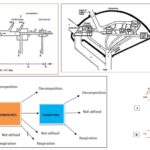IB Biology 11 Views 1 Answers
Sourav PanLv 9November 9, 2024
Where do the light-independent reactions (Calvin Cycle) occur within the chloroplast?
Where do the light-independent reactions (Calvin Cycle) occur within the chloroplast?
Please login to save the post
Please login to submit an answer.
Sourav PanLv 9May 15, 2025
The light-independent reactions, commonly known as the Calvin Cycle, occur in the stroma of the chloroplast. The stroma is the fluid-filled space surrounding the thylakoid membranes, where various enzymes necessary for these reactions are located.During the Calvin Cycle, carbon dioxide (CO₂) is fixed into organic molecules using ATP and NADPH produced from the light-dependent reactions. The cycle consists of three main phases:
- Carboxylation: CO₂ is attached to ribulose bisphosphate (RuBP) by the enzyme RuBisCO, forming 3-phosphoglycerate (3-PGA).
- Reduction: ATP and NADPH are used to convert 3-PGA into glyceraldehyde-3-phosphate (G3P), a three-carbon sugar.
- Regeneration: RuBP is regenerated from G3P, allowing the cycle to continue and enabling further CO₂ fixation.
This process can occur both in light and dark conditions, although it indirectly relies on the products of light-dependent reactions for energy and reducing power
0
0 likes
- Share on Facebook
- Share on Twitter
- Share on LinkedIn
0 found this helpful out of 0 votes
Helpful: 0%
Helpful: 0%
Was this page helpful?




